MotoGP 18 is a motorbike simulation racing game available from retail stores and for download from PlayStation Store for PS4. MotoGP is the pinnacle of motorbike racing with the first-ever MotoGP season taking place across six races for the 125cc, 250cc, 350cc, 500cc, sidecar 600cc and constructors’ 500cc world championship in 1949. The first-ever MotoGP race rather unbelievably took place on June 17th 1949 at the Isle of Man TT within the 250cc, 350cc and 500cc categories with Manliff Barrington, Freddie Frith and Harold Daniell winning their respective 250cc, 350cc and 500cc race, while the Isle of Man also hosted the longest ever MotoGP race in 1957 with eight laps totalling to 301.84 miles which was won by Bob McIntyre. Nello Pagani, Bruno Ruffo, Freddie Frith, Leslie Graham, Eric Oliver/Denis Jenkinson and AJS went onto win their respective 125cc, 250cc, 350cc, 500cc, sidecar 600cc and constructors’ 500cc world championship category titles to etch their names in history during MotoGP’s debut season in 1949.
MotoGP 18 is the official game based upon the 70th season of MotoGP, although there have been other MotoGP games licensed to a specific season such as Namco’s MotoGP games released within the PS2 generation, THQ’s MotoGP games released within the original Xbox generation and Capcom’s MotoGP games during the earlier years of the PS3 generation. Milestone got their first taste of MotoGP when developing MotoGP 07 and MotoGP 08 for Capcom before purchasing the rights to develop and publish their own MotoGP games starting with MotoGP 13. Milestone has a great pedigree of not only developing great racing games, but priding themselves on the authenticity of the racing experience which is what has forged their history of exceptional sports racing games as the Italian passion of motorsports radiates from their games in the home of Ferrari and Ducati. Milestone has been especially prolific with multiple iterations throughout various forms of motorbike racing including SBK, Motocross and MotoGP. Can Milestone Italy not only improve, but also reinvent MotoGP gaming in MotoGP 18 and how will it compare to previous efforts from Namco, THQ, Capcom and Milestone Italy within the MotoGP series?
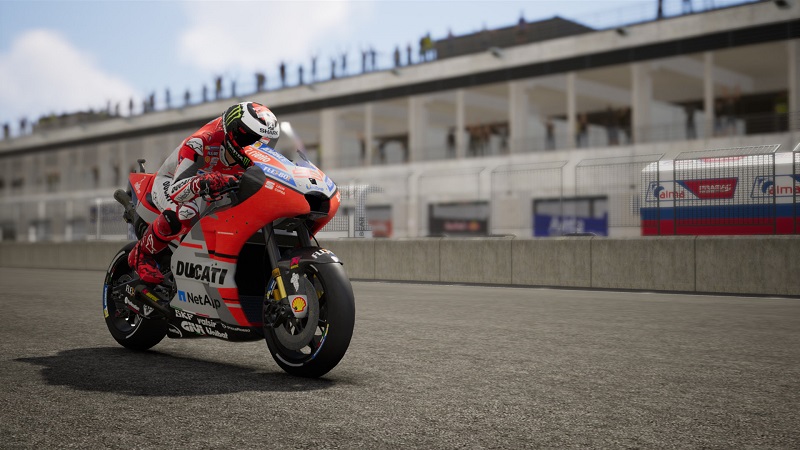
MotoGP 18 features all of the official licenses for the 2018 season which comprises of 19 tracks situated in various locations around the world including: Losail, Qatar; Termas de Rio Hondo, Argentina; Austin, USA; Jerez, Spain; Le Mans, France; Mugello, Italy; Catalunya, Spain; Assen, Holland; Sachsenring, Germany; Brno, Czech Republic; Spielberg, Austria; Silverstone, Great Britain; Misano, San Marino; Aragón, Spain; the introduction of Buriram, Thailand; Motegi, Japan; Phillip Island, Australia; Sepang, Malaysia; and Valencia, Spain, while there are no classic tracks or any tracks from previous seasons. Meanwhile, there are 24 MotoGP riders, 32 Moto2 riders, 28 Moto3 riders and 26 Red Bull MotoGP Rookies Cup riders which totals to 110 riders from the 2018 season. Every bike and team is also officially licensed such as Aprilia, Ducati, Honda, Kalex Engineering, KTM, Speed Up Racing, Suzuki, Tech 3 Racing, Yamaha and many more besides.
Gameplay begins with an optional set of tutorials including basic, semi-pro and pro tutorials followed by an overview of what’s new. Basic tutorial teaches the player how to brake when entering the corner and accelerate out of the corner and into the straight with two laps provided to successfully pass every checkpoint at the allocated speed for each checkpoint, albeit within a time trial styled scenario. Semi-pro tutorial teaches deceleration during braking by clearly defining the braking zones when brake assists are turned off, while pro tutorial is a much tougher test that teaches the ideal trajectory and how to utilise the pro riding style to achieve that in order to not only complete a lap within the time limit but to also exceed the required precision percentage with every tutorial taking place at the Czech Republic Grand Prix track.
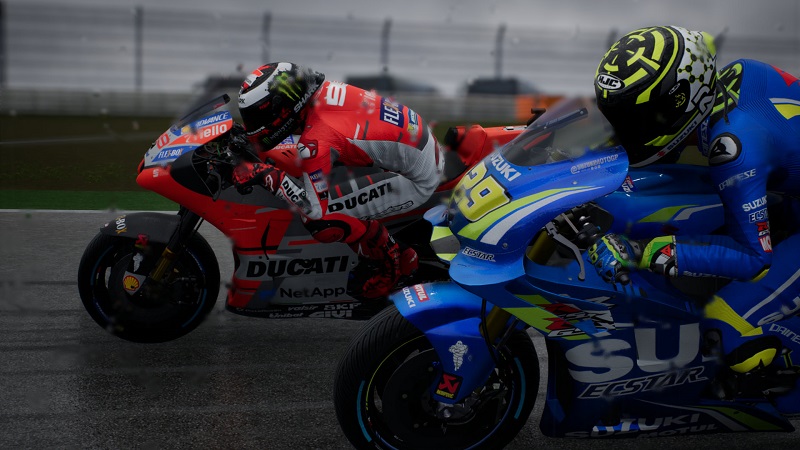
Career mode starts out in the Red Bull MotoGP Rookies Cup which has made the transition from downloadable content in previous MotoGP games to being immediately available in MotoGP 18. Teams from MotoGP, Moto2 and Moto3 categories have always scouted the best up and coming talents from the Red Bull MotoGP Rookies Cup since it was introduced in 2007, especially given how the category challenges young riders to perform to the best of their ability on the best tracks situated throughout Europe on a KTM RC 250 R bike that is modelled closely to the Moto3 bike specifications. Unlike MotoGP 17 when the player began career mode on the sixth race weekend of the seven race Red Bull MotoGP Rookies Cup; MotoGP 18 has the player starting their career mode from the very first race of the season in Jerez, Spain. Winning or performing to a high standard in the Red Bull MotoGP Rookies Cup will earn you the chance of a promotion to race in the Moto3 category. E-mails from your personal manager will congratulate you on a job well done; inform you of race weekend objectives and new opportunities such as contract offers from teams in any category. Meanwhile, social feeds provide statistics for riders during the current season and historical facts for what happened on this day in MotoGP categories.
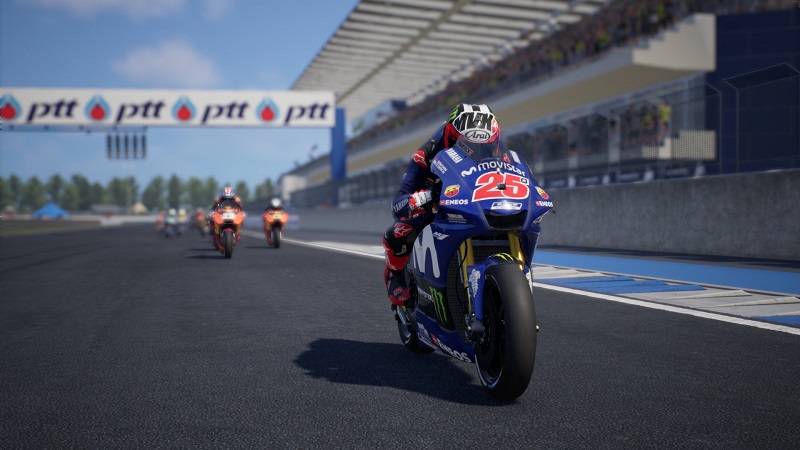
Choosing a promotion to the Moto3 category requires some thought and strategy as to if you want to push for a podium finish in every race or progress through the grid from towards the back of the field. Winning the Red Bull MotoGP Rookies Cup earns 9 offers from teams in the Moto3 category. Every offer has multiple factors to consider including an initial trust of how close the rider is to dismissal if his performance drops below that of the team’s expectations. However, the flipside of that is if the rider’s performance exceeds the expectations of the team until your rider becomes the team’s first rider as each team has varying expectations from an anticipated rider’s championship position of 15th to 8th in order to retain your race seat in accordance with each team’s performance. Your chosen team also has a range of race weekend objectives including qualifying position, race position and finishing ahead of your teammates; achieving your team’s race weekend objectives gradually progresses the player towards being the team’s first rider. Whereas the Red Bull MotoGP Rookies Cup is a 7 race season; Moto3 is a massive step-up to a 19 race season in parallel to the tracks contained within the MotoGP season calendar as you continue your venture towards not only ascending into the MotoGP category, but also attempting to win the ultimate prize in all of competitive motorbike racing by becoming MotoGP champion.

A major overhaul within career mode sees the introduction of practice session programmes to progressively improve the specifications of your bike over the course of the season; therefore providing more of a purpose to practice sessions instead of learning the track within a few laps and skipping the rest of the practice sessions. However, there is some strategy involved as the practice session programmes yield a limited budget for bike upgrades including 7 engine traction and power upgrades; half a dozen brake modularity and aggression upgrades; half a dozen hydraulics and elasticity upgrades; 8 frame upgrades for lean angle and bike stiffness settings; and 3 aerodynamic penetration and downforce upgrades that all cost varying quantities of research and development points. There is a specific practice programme test for each of the five core components of your bike. For instance, a speedtrap engine test challenges the player to accelerating above a certain speed through a multitude of speedtraps situated throughout the track that each provide 200 or more research and development points, although rather interestingly 10 more points are awarded as a bonus for accelerating every 1km/h above the expected speed within each speedtrap; therefore providing a constant motivation to push the relevant area of the bike in each test in order to earn the maximum research and development points before upgrading the bike. Elsewhere, the braking test sees the player needing to apply the brakes within a clearly indicated braking zone in five different areas of the track with up to 400 points per braking zone on offer; trajectory test analyses the handling via the positioning of your bike during the approach in entering and exiting four major corners; and the complete test includes the speedtrap, braking and trajectory tests.
Every setting within race options and riding aids are fully customisable, although selecting the easiest settings gradually reduces your reputation bonus until it reaches 0%; therefore providing a risk and reward gameplay element within career mode as reputation points is the very thing that will attract teams from a higher category to produce a firm contract offer. Reputation points is measured in how many new fans you earn throughout the course of a race weekend, so is more likely at first to be in the hundreds instead of thousands. There is an interesting approach to XP and levelling up in coordination with reputation points as your customised rider begins at level 40 throughout four major skills including riding position, throttle management, brakes management and leaning angle with each skill improving after every race in career mode depending on the quantity of fans earned through your finishing position.
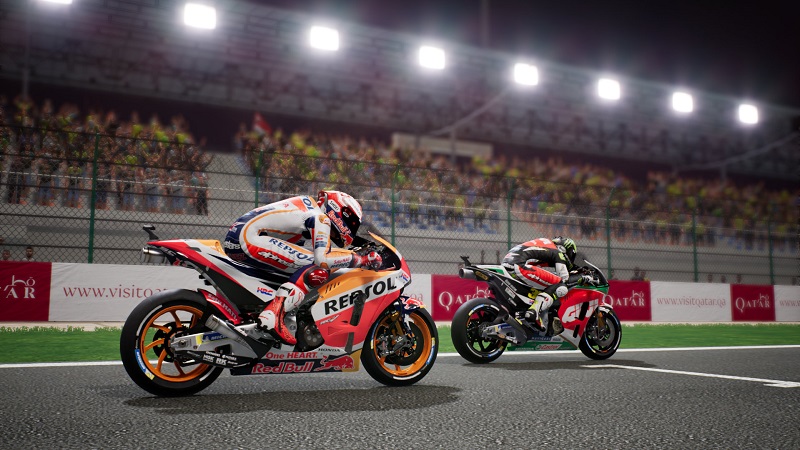
Grand Prix mode provides the opportunity of racing on a single track with the ability to have a full race weekend, qualifying and race or only a race competing against 23 MotoGP opponents or as many as 31 opponents in Moto2. When selecting Grand Prix mode; you can choose any of the official riders, bikes and teams or alternatively select your custom rider from the MotoGP, Moto2, Moto3 and Red Bull MotoGP Rookies Cup categories, alongside any of the 19 tracks and retaining the freedom to adjust the race length between 15%, 25%, 35%, 50% or a full length race distance for each circuit, A.I. difficulty and full customisation of riding aids to your ideal preferences. There are also various areas of customisation to complement everything else such as variable weather conditions; light, realistic or no bike damage; tyre wear; manual start management; and no penalties, penalties or official rules.
Championship mode allows you to create your own championship season comprising of races against 23 MotoGP opponents or as many as 31 opponents in Moto2 which is customisable to your preferences as the championship will be the official 19 race calendar of the MotoGP season, although you can customise the race calendar to a minimum of two races and a maximum of 19 races including the ability to repeat your favourite tracks anywhere amongst the calendar as many times as you wish within a championship season, alongside the same riders, bikes, teams, race options and riding aids as Grand Prix mode.
Time Attack mode provides players with the opportunity to set the best lap time around any of the 19 tracks in an attempt to climb the online leaderboards representing the fastest lap times as you compete against players from across the world to see who performs the best lap time in a one lap scenario, although you can complete as many laps as you wish with a full selection of riders, bikes and teams from all 4 classes or your custom rider, while you can also customise weather conditions to make them as unpredictable as you prefer and full customisation of riding aids to your ideal preferences.
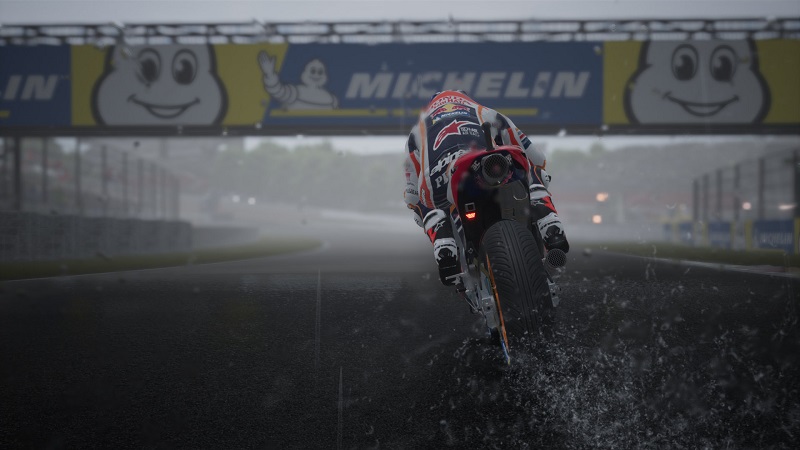
MotoGP 18 does introduce its fair share of new features and enhancements including the ability to contrast and compare the statistics of your MotoGP ID with every player globally; research and development practice programmes in career mode; pre-race starting grid featuring riders, team members and umbrella grid girls; dynamic race starts via the addition of releasing the clutch to perform perfectly timed manual starts to the best of your ability; post-race podiums were the top three riders are presented with their hard earned trophies and spray champagne in celebration; an entirely new graphics engine in the form of Unreal Engine 4; laser scanning of every rider’s face; and photogrammetry for every track.
However, MotoGP 18 does not contain all of MotoGP 17’s features. A major feature from MotoGP 17 was the inclusion of 76 historic riders with their respective bikes and teams in their 125cc two-stroke, 250cc two-stroke, 500cc two-stroke and MotoGP four-stroke historic categories. However, historic riders, bikes, teams and categories does not make a return in MotoGP 18, although given the increased amount of detail added to every rider; it would be forgiven if historic riders, bikes, teams and categories make a return with improved visual fidelity in a sequel to MotoGP 18. However, MotoGP 17 also featured accurate representations of every rider’s unique performance percentage statistics that outlined their respective strengths and weaknesses including braking, throttle management, cornering and body positioning, although that does not return in MotoGP 18; perhaps due to the emphasis on the rider’s much improved visuals, so it would be nice to see the statistics reintroduced in a sequel to MotoGP 18. A further significant feature from MotoGP 17 that does not return in MotoGP 18 is the Managerial Career mode that challenged the player to create their own team and rise through the ranks from the back of the Moto3 grid to the front of MotoGP, albeit managing everything within the team and having the chance to ride the bike in partnership with sponsors and teammate to help your team progress onwards and upwards. Managerial Career mode is undoubtedly a massive miss for MotoGP 18 due to how it took MotoGP 17 into an avenue that not many motorsports simulations strive to embrace and should be brought back for future sequels. MotoGP 15’s excellent Special Events mode has not been brought back for MotoGP 18. Special Events would have certainly fitted in as there is always drama in motorsports; therefore the Real Events in which the player must replicate what happened in favour of some riders’ positive results during race weekends throughout the season or changing the outcome after a rider has had a problem to recover to the podium to preserve their championship hopes is always a relevant feature and one that future MotoGP games would benefit from re-introducing.

Weather conditions include clear blue skies with no risk of rain; overcast with a possibility of rain; torrential rain throughout the duration of the race; a wet track; and even random weather conditions that are capable of presenting any form of weather in the build-up to and during the race. Unreal Engine 4’s graphical improvements are apparent during wet weather conditions. For instance, during a direct comparison between MotoGP 18 and MotoGP 17 in full wet track conditions on Silverstone when raining it becomes clear that while MotoGP 17 has droplets of rain on the camera, water splashing up off the track surface as bikes ride through it and reflections of the trackside buildings within the wet track surface; MotoGP 18 enhances the detail of everything that could be reflected on the wet track surface and has a better density of water puddles instead of being one continuous wet track surface. All weather conditions are modelled more accurately than ever due to Unreal Engine 4, while continuing to present a unique challenge as each type of weather will make your bike behave differently; particularly in relation to how difficult your bike handles during high speed acceleration and upon the entrance and exit of corners during braking zones. One of the most challenging weather conditions has to be the wet track creating a scenario in which the sun has came out but not for long enough to entirely dry the track providing its own complexities as riders will need to start on wet tyres yet the normal racing line will gradually become dry as the water is dispersed from the bikes riding through it, therefore riders will have to adjust their racing lines to follow where the wet patches are situated within each straight and corner in order for the wet tyres to be kept within their optimum performance.
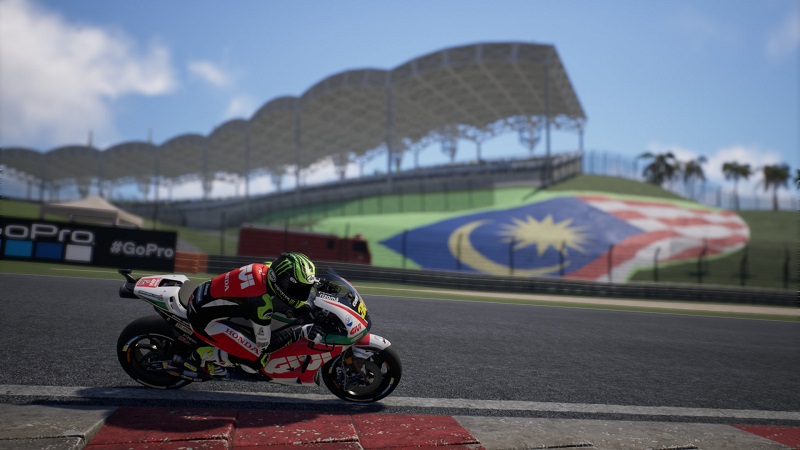
Bike setup can be changed in the pits which can potentially provide a significant performance advantage if you experiment enough in an attempt to absolutely perfect your bike setup for each track. Bike setup is spread across half a dozen categories including tyre compound, suspension, steering adjustment, gear ratio, brake system and ECU with each category having various settings such as the ability to choose a soft, medium or hard front and rear tyre compound that can also be alternated such as a hard front and a medium rear tyre compound; changing the suspension by adjusting the front and rear preload, rebound and compression fork and single shock absorber and front and rear damping of springs; changing the steering adjustment by adjusting steering head inclination rake and trail; changing the gear ratio by selecting a maximum speed for all six gears and the final gear ratio from a set of 10 point sliders; changing the brake system by selecting a smaller or larger front and rear brake disc; and choosing the strength of the engine brake and traction control system (TCS) from 4 point sliders. However, there is also the ability to communicate with your race engineer in order to discuss what feels wrong on the bike and to fix it accordingly such as mentioning that the steering responsiveness of the bike is generally too slow or fast results in a suggestion of raising the front and rear of the bike by decreasing fork preload, stiffer front and rear springs, increasing front and rear compression damping, decreasing front and rear rebound damping and decreasing rake and trail or alternatively changing the settings to the total opposite if the steering responsiveness is too fast will be offered by the race engineer which you can decide to accept or ignore. Realistic communication between the rider and race engineer certainly produces an appropriate level of realism that provides a real element of strategy to gameplay in almost every mode and increases competitiveness even further. There are options to save, load or delete your preferred bike setups and to return your bike setup to its former default setup.
Players can customise their rider at the beginning of career mode or from the rider customisation menu which allows you to customise your rider licence from your rider’s facial portrait from a choice of 10 pre-set faces, first name, surname, abbreviation, age, nationality, racing number, 4 font styles and 200 font colours, nickname, 4 nickname font styles and 200 nickname colours, alongside a selection of rider gear including 81 crash helmet designs, 90 glove designs and 50 boot designs. The largest area of the rider customisation feature has to be choosing your riding style which consists of five available pre-sets including balanced, elbows to the ground, shoulders out, body out and old school which is a great feature that even educates the player on the difference of rider positioning for each riding style resulting in players being able to ride their motorbike in the style of their favourite MotoGP rider, although it would have been even better if the player was able to meticulously create their own unique riding style in what would have been similar in approach to Milestone Italy’s Ride series.

There are five excellently positioned camera angles including a camera angle positioned directly behind the rider, while the second and third camera angles are positioned further back to provide three separate views of the bike, opposing bikes and the track surface up ahead amongst the surrounding environments which certainly caters for the appropriate distances of third-person perspectives. There are three first-person perspectives providing a realistic and accurate representation of the cockpit including an LCD dashboard and speedometer to display your current speed, alongside the handle bars and crash visor, while there is another accurate portrayal of the cockpit albeit from the actual rider’s eye view looking out through the crash helmet, although unlike previous MotoGP games; the rider’s peripheral vision is not limited at the top and bottom of the camera angle and the final first-person camera is positioned on the front of the bike looking outwards without showing any bodywork. There is no optional re-positioning of the camera angle to bring it closer to or further away from the bike as has been expertly utilised in WRC 4 on Vita and MXGP on PS3; allowing you to move a slide bar 20 clicks further forwards or backwards from the rider to customise a third-person perspective that is suited to your preferences, although the focus of all five camera angles can be adjusted in order to look to the left, right, above, below or behind the rider.
Photo mode is available from the pause menu; allowing you to observe the closer details of the racing in the foreground and trackside environments. Photo mode is a really great feature; allowing the camera to be positioned with freedom within the vicinity of the racing action including extensive customisation of images such as panning, camera height, zooming in or out and anywhere from a minor tilt to a full sideways tilt, alongside the ability to hide opponents, position the logo in any corner and choose from a 16:9, widescreen 2.35:1 or square 1:1 display ratio; aperture and focus distance; exposure, contrast and brightness; and half a dozen masks over the picture, nine image filters and the intensity of the picture in a fully immersive environment which works in perfect harmony with the PS4’s share feature.
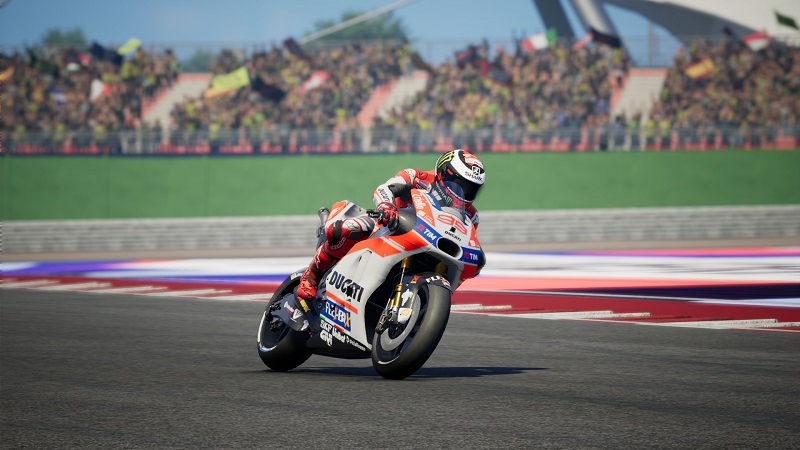
You can watch a full race replay with the ability to watch in slow motion, pause, fast forward, rewind, change the camera angles for a different view of the action and to view the action from the previous or next rider. You can view the replay from seven camera angles including a dynamic camera angle positioned away from the bike with the TV camera angle changing from camera to camera in the style of Gran Turismo, while one of the third-person gameplay views is positioned closer behind the rider; a first-person cockpit gameplay viewpoint; a first-person perspective looking directly ahead showing none of the bike’s bodywork; a camera mounted towards the rear of the bike which highlights the weight distribution of the rider through corners; the handlebar camera is somewhat inverted in comparison to the rider’s eye view as you get to view the action looking backwards at your rider as he spots the braking points, leans into corners and tucks in during straights; and a rear wheel mounted camera angle positioned just offset showing the rotation of the rear wheel respectively with a clear view of the riders that you have overtaken being left in your trail amongst the scenery, while showing the amount of load going through the bike particularly when braking. It would be great to see some of these camera angles such as the rear wheel mounted camera that could automatically switch from one side of the wheel to the other depending upon the direction of the upcoming corner or the Gran Turismo style dynamic TV coverage; make the transition to being playable as you are riding as they would further complement the immersion within the authenticity of the racing experience, while the same can be said for some of the gameplay camera angles being brought over to the replay coverage such as the rider’s eye view and the further third-person camera angle. It would have been amazing for the gameplay and replay camera angles to include a helicopter camera angle from high above the circuit following the action with the sound effect of the helicopter in the audio mix.
It is disappointing not to see a Vita release of MotoGP 18 after the excellent retail releases for MotoGP 13 and 14 on Vita, although remote play is a consolation. MotoGP 18’s remote play performance is excellent as the graphics, audio and general performance are the same quality as the PS4 version, while the control scheme has been optimised resulting in acceleration being remapped from R2 to the bottom right of the touch screen and braking has moved from L2 to the bottom left of the touch screen, although they would have been better suited to R and L respectively, especially as you may have to lift your thumb from steering with the left analogue stick to brake. I had the best remote play experience with MotoGP 18 after customising the control scheme in which acceleration and braking was remapped to R1 and L1 respectively with rewinding moving to the bottom right of the touch screen or the top right of the rear touch pad and engaging the clutch moving from L1 to the bottom left of the touch screen or the top left of the rear touch pad; therefore providing a comfortable control scheme much better suited to the racing genre.
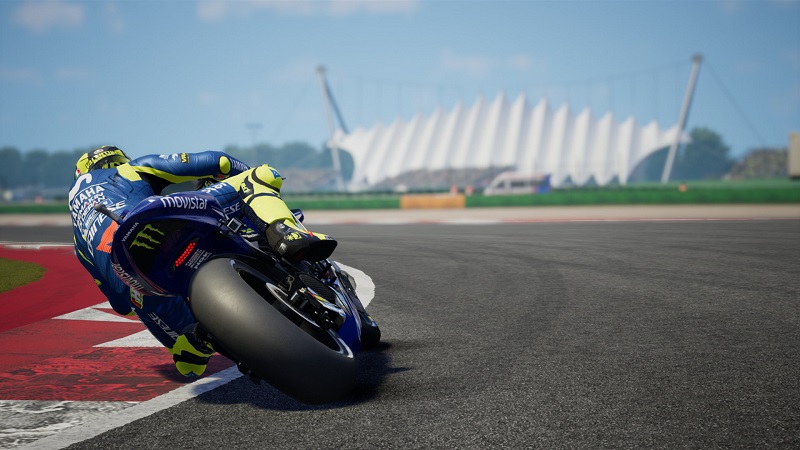
The controls are well mapped to the DualShock 4 controller and are fully customisable. The default control scheme consists of pressing R2 to accelerate; pressing L2 to use the front brake or reverse; holding L1 to engage the clutch during a manual start; pressing R1 to rewind following a crash or loss of direction; pressing X to use the rear brake; pressing O to manually shift up a gear; pressing square to manually shift down a gear; pressing triangle to tuck-in for the best aerodynamic positioning of your rider; moving the direction of the left analogue stick to the left or right to steer your bike in that direction; moving the direction of the left analogue stick forwards or backwards to appropriately distribute your rider’s weight; moving the direction of the right analogue stick to the left, right, upwards or downwards to focus the camera in that direction; pressing R3 to view behind your rider; pressing up or down on the d-pad to increase or decrease electronics levels; pressing right or left to scroll through to the next or previous electronics options respectively; pressing the share button takes you to the share feature menu; and pressing the options button to display the pause menu.
There is no gyroscopic motion sensing functionality which is surprising as it could have provided an alternative steering method to the left analogue stick, while the touch pad implementation is under utilised as it only changes the camera angle, whereas an optional control scheme of MotoGP 13 on Vita included tapping the appropriate side of the rear touch pad to shift up or down a gear. Vibration is a lot more subtle in comparison to MotoGP 17 that is usually only showing any immersion when riding the bike onto a curb, but is otherwise not as immersive as MotoGP 17. Whereas the light bar previously produced a variety of colours during differing stages of each gear shift; MotoGP 18 has unexpectedly removed all light bar implementation in favour of a standard blue light bar colour.

Graphically, MotoGP 18 introduces an all new Unreal Engine 4 graphics engine that elevates the realism to a previously never seen before height in MotoGP gaming including laser scanning of every rider’s face and photogrammetry for each track to present a full 1:1 representation of MotoGP. Elsewhere, bikes and riders have authentic models and lean angles; weather conditions show greater realism, while trackside environments are more detailed in their complexity and fans are far more animated with realistic smoke effects depicting the yellow flares showing where Valentino Rossi’s adoring fans are situated around the track’s grandstands. However, some textures take a couple of seconds to load in certain pit, pre-race and post-race areas on every track, while trackside lighting and shadows could still be improved on some tracks such as when the colour palette seemingly changes to add a lighting or shadow effect as your rider is very close to the barrier, foliage or grandstand that is especially clear at Jerez.
MotoGP 18’s presentation is solid with a great user interface across various menus such as the main menu, career mode menus, quick mode menu, Grand Prix menus, Championship menus, Time Attack menus, online multiplayer menus, online leaderboards, rider customisation menus, options menus and various gameplay menus with support for navigation via the left analogue stick, directional pad and face buttons, although it does not include support for navigation via the right analogue stick or touch pad. Menu backgrounds consist of one of the front running MotoGP bikes such as Valentino Rossi’s Yamaha surrounded by the aerodynamically funnelled air situated around the bike. Loading screens are as good in their presentation as the menus as they contain analysis of the track you are about to ride on with a track map showcasing the split time sectors, right-hand bends and left-hand bends to keep you occupied during any loading times. Everything has an air of TV style presentation with pre-race videos that provide a build-up to the race by showing the culture and hospitality of the host city which carries through to the gameplay with track facts such as length, width, quantity of corners and length of straights; air and track temperature; data overlays of the gaps between two riders who are duelling for position; when a rider has been involved in a collision with another rider or has crashed; fastest lap; pre-race grid sequences; grid line-up; warm-up lap; podiums; and much more besides presented exactly as you would expect to see it when watching professional television coverage.
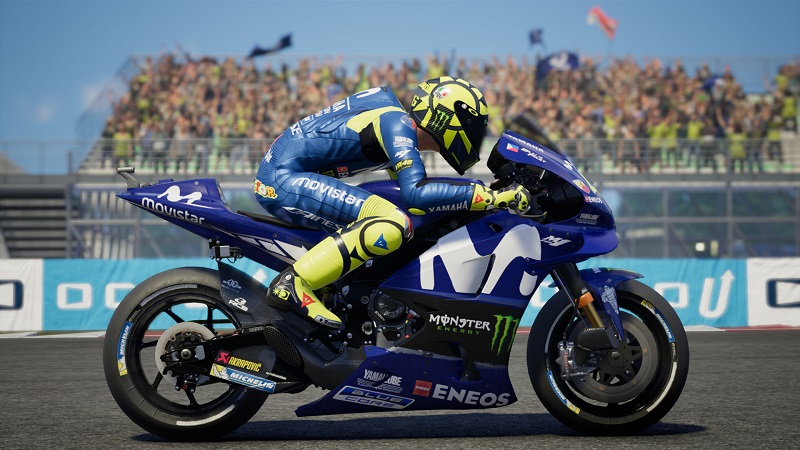
Pre-session introductions and post-session analysis returns which creates some atmosphere around the race weekend, although well known BT Sport MotoGP commentator and journalist Gavin Emmett does not return. Meanwhile, there is still no commentary during practice, qualifying and race sessions which would certainly have increased immersion through having BT Sport commentators Keith Huewen and Neil Hodgson calling the action. Sound effects include revving bike engines, running over curbs, weather conditions such as rain and ambience as the much improved involving atmospheric crowd cheers on their favourite riders make their way past their grandstands, during post-race paddock celebrations and podium; complimented by an upbeat instrumental rock theme during menus. There is no DualShock 4 speaker implementation that could have produced any layer of audio such as bike engines, collisions, pre-session and post-session commentary or ambient sounds from the atmospheric crowd.

The trophy list includes 51 trophies with 38 bronze trophies, 10 silver trophies, 2 gold trophies and 1 platinum trophy. The majority of the trophies are based upon skill as you are required to win races across various scenarios such as 18 bronze trophies for winning at 18 tracks in Grand Pix, Championship or Career mode. There are 5 bronze trophies for completing 1, 5, 10, 15 and 20 online multiplayer races. The hardest trophies include the A Proven Tester silver trophy for successfully passing 10 different tests during practice programmes in Career mode; the Trusted by the Team silver trophy for reaching the team objective 30 times in Career mode; and the MotoGP World Champion gold trophy for becoming MotoGP world champion in Career mode. It is estimated that depending upon skill and a good trophy guide to provide some helpful tips that it would take between 20 to 25 hours to platinum the trophy list.
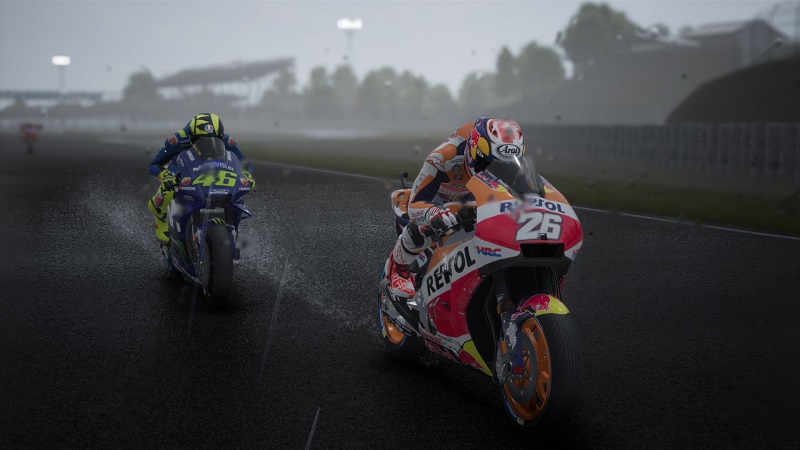
There are half a dozen difficulty levels including very easy, easy, medium, hard, realistic and extreme with the major differences between difficulty levels being the A.I. will become gradually more clinical with each step up in difficulty as they will wait for an appropriate overtaking opportunity and capitalise on any mistake you make. There are further factors involved in the difficulty level besides the A.I. as there are three physics settings including assisted, normal and pro which increase the corresponding difficulty curve as the three physics settings each provide totally different handling. Assisted physics feel more arcade oriented with a much lower chance of crashing when you have become accustomed to the handling, while the normal physics strikes a balance between assisted and pro physics as the pro physics are far more realistic and fully depend upon you perfecting the weight distribution of your rider’s lean angles and braking accurately throughout every corner of the track. The rewind mechanic can reduce the difficulty by having numerous opportunities to rewind back to before a crash occurred. Between the half a dozen difficulty levels, three physics settings and plenty of riding assists which can be turned on or off; players have full customisation over the degree of challenge they wish to encounter in any single player mode as well as the difficulty for A.I. controlled riders, physics, gear shifts and riding assists in online multiplayer.
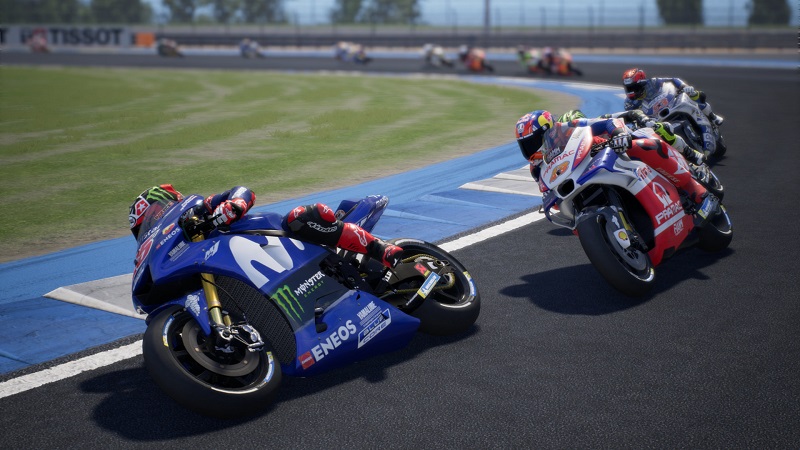
Rather inexplicably, instead of Unreal Engine 4 helping to improve the MotoGP franchise’s split-screen multiplayer performance; there is actually no split-screen multiplayer at all.
Online multiplayer performance is mostly as good as single player during gameplay with the same sense of speed, graphics, up to 12 players and the capability of A.I. fleshing out the field, although there is a bit of lag that occurs here and there and too many disconnections from an online lobby after an online multiplayer race has been completed. If a player joins an online multiplayer lobby in which the race is already under way, then you will not be able to immediately join the race, although the player will be able to view the race as a spectator.
Online multiplayer includes public race mode that immediately searches to find an online lobby as quickly as possible, while private race mode provides the ability for players to create their own customised lobby and invite players into their online lobby with a choice of a single race or championship with additional options including any of the 4 bike classes; 4 sets of physics including a free choice for each player, assisted, normal or pro physics; collisions; tyre wear; A.I. difficulty between very easy, easy, medium, hard, realistic, extreme or no A.I. opponents; semi-automatic, manual or a free choice of transmission; the number of races within a championship from 3 to 19; the option of a qualifying session; and race settings selection policies for lobby host or voting on a shortlist of 4 tracks to race on. However, there are not as many online lobby creation or preference options in comparison to MotoGP 17, while online co-op season does not return.
Time Attack online leaderboards focus on fastest times from each player with rankings covering all 19 tracks across all 4 classes with each leaderboard containing each player’s rank; name (PSN ID); the bike, manufacturer and physics setting used during the player’s fastest time; and the best time set by each player, while players can compare their positioning on the leaderboards with players that occupy the top positions, globally, from your friends list and to immediately find and display your position within any given leaderboard.
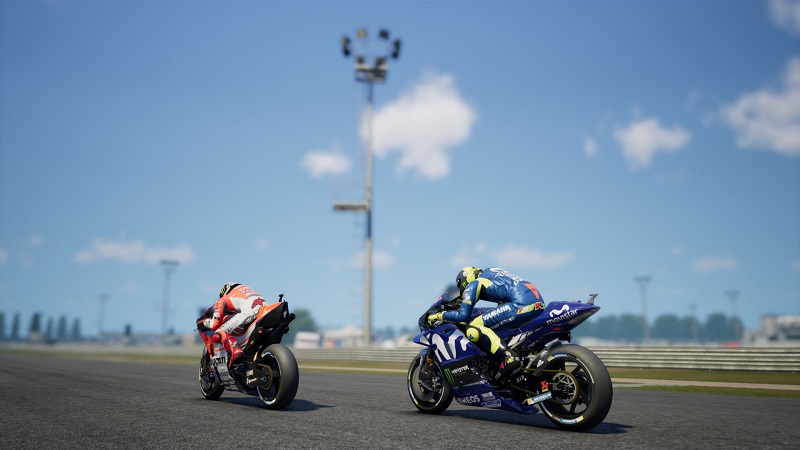
MotoGP 18’s replayability is tough to call as there are new features such as research and development practice programmes in career mode, dynamic race starts, pre-race grid and post-race podium sequences and more besides, although there are more features removed in comparison to MotoGP 17 including historic riders and teams, split-screen multiplayer, online co-op season and managerial career mode than those that have been introduced. However, there is still a lot of replay value in rising through the ranks from the back of the grid in the Red Bull MotoGP Rookies Cup to winning the MotoGP rider’s championship and everything else in between in career mode.
Analysis
- Title: MotoGP 18
- Developer: Milestone Italy
- Publisher: PQube
- System: PS4
- Format: PS4 Blu-Ray Disc/PSN Download
- Cross-Buy: No
- Cross-Play: No
- Players: 1/2-12 (Online Competitive Multiplayer)/Online Leaderboards
- Hard Drive Space Required: 16.14GB (Version 1.12 – PS4 Blu-Ray Disc/PSN Download)


















